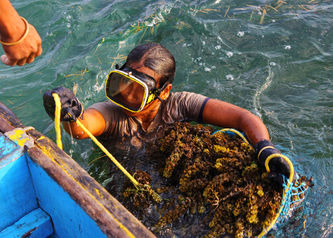The first rays of daylight are yet to grace the ground when a group of seven women set out from their homes. Leaving dimly lit streets and coconut groves, they walk towards the seashore. At the far end of the land, a few fishermen have made a small wood fire to escape the morning chill. The women approach the fire and warm their hands. The time is ripe to face the elements. They slowly wade through knee-depth water and climb a boat waiting exclusively for them. The first woman to board the boat carefully move towards the bow. With a long wooden pole, she keeps the vessel steady against the waves. Once everyone settles inside, the lone male crew member starts the engine. Against the backdrop of orange-red flames of the shore fire, the boat’s engine growls to life, giving out thick dark fumes. Leaving the handful of fishermen on the shore as witnesses, the boat cruises on the Gulf of Mannar.
A shallow bay and protected area, the Gulf of Mannar forms a small portion of the vast Indian Ocean. It lies between the southeastern tip of India and the western coast of Sri Lanka. Thanks to its rich aquatic life, the Gulf provides livelihood to thousands of people on its shore. Keelakkarai is one such place where the destiny of its residents is closely knitted with the mood swings of the water. Located in Ramanathapuram district, this village often faces the wrath of nature, usually in the form of cyclonic storms. The 2005-Indian Ocean tsunami ravaged the region and it is still afresh in the memories of the residents. Unlike most fishing hamlets, women here have found a profession often reserved for men.
Their working ground is the shallow seabed where bleached corals harbour a particular aquatic plant called seaweed. Found in different varieties, seaweeds are a much sought-after commodity by industries, especially the cosmetics and food sectors. The price of each kind varies according to season and usage. Decades of sea-going experience have taught these women where to locate a particular weed. This aquatic plant exhibits a spectrum of colours and the shallow sea, too, will reflect these hues according to the kind of seaweed growing below. Once a harvesting spot is located, the women prepare to dive by anchoring the boat. With their basic swimming gear – a face-covering glass to protect eyes from salt water, a pair of gloves to pluck the thorny seaweeds, a pair of rubber sandals, and a net to bag their catch – the crew dives to the seabed. For the next three to four hours they dive several times and return with their net full of seaweed. The exercise continues till midday when the waves start glittering under the scorching sun. With the sun above their heads, the crew decides to return to shore. The boat turns around for its homeward cruise. It is time for lunch and friendly chatter. The crew takes out the homemade food they have brought and shares it among themselves. The struggle of the last three-four hours gives way to moments of relief.



















